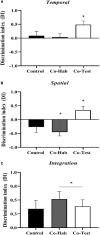Conspecific Presence Improves Episodic-Like Memory in Rats
- PMID: 33519391
- PMCID: PMC7844209
- DOI: 10.3389/fnbeh.2020.572150
Conspecific Presence Improves Episodic-Like Memory in Rats
Abstract
A number of studies have provided evidence that animals, including rats, remember past episodes. However, few experiments have addressed episodic-like memory from a social perspective. In the present study, we evaluated Wistar rats in the WWWhen/ELM task as single setups and in dyads, applying a long retention interval. We also investigated behaviors that could subserve the emergence of this type of memory. We found that only rats tested in the social setting were able to recollect an integrated episodic-like memory that lasted 24 h. Additionally, rats in dyads presented higher levels of exploration during the task. When exposed to the testing environment, the dyads exhibited affiliative behavior toward each other and presented fewer anxiety-like responses. Our findings indicate that the presence of a conspecific could act as a facilitating factor in memory evaluations based on spontaneous exploration of objects and provide empirical support for applying more naturalistic settings in investigations of episodic-like memory in rats.
Keywords: Wistar rats; anxiety-like behavior; episodic-like memory; exploration; social environment.
Copyright © 2021 de França Malheiros, Castelo-Branco, de Medeiros, Marinho, Meurer and Barbosa.
Conflict of interest statement
The authors declare that the research was conducted in the absence of any commercial or financial relationships that could be construed as a potential conflict of interest.
Figures



References
-
- Barnett S. A. (1976). The Rat. A Study in Behavior. Canberra: Australian National University Press.
-
- Barnett S. A. (2009a). An analysis of social behaviour in wild rats. Proc. Zool. Soc. Lond. 130 107–152. 10.1111/j.1096-3642.1958.tb00565.x - DOI
LinkOut - more resources
Full Text Sources
Other Literature Sources
Miscellaneous

